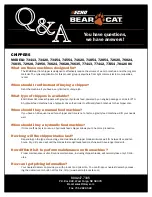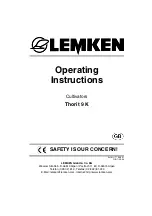
Installation Electrical
RTAF-SVX001K-EN
47
Relay Assignments Using
Tracer TU
Tracer™ TU Service Tool is used to install the
Programmable Relay Option package and assign any of
the above lists of events or status to each of the four relays
provided with the option. The relays to be programmed
are referred to by the relay’s terminal numbers on the LLID
board 1K23.
The default assignments for the four available relays of the
Programmable Relay option are:
If any of the Alarm/Status relays are used, provide
electrical power, 115 VAC with fused-disconnect to the
panel and wire through the appropriate relays (terminals
on 1A10). Provide wiring (switched hot, neutral, and
ground connections) to the remote annunciation devices.
Do not use power from the chiller’s control panel
transformer to power these remote devices. See the field
diagrams which are shipped with the unit.
Low Voltage Wiring
The remote devices described below require low voltage
wiring. All wiring to and from these remote input devices
to the Control Panel must be made with shielded, twisted
pair conductors. Be sure to ground the shielding only at
the panel.
Important:
To prevent control malfunctions, do not run
low voltage wiring (<30 V) in conduit with
conductors carrying more than 30 volts.
Emergency Stop
Symbio™ 800 provides auxiliary control for a customer
specified/installed latching trip out. When this customer-
furnished remote contact 6S2 is provided, the chiller will
run normally when the contact is closed. When the contact
opens, the unit will trip on a manually resettable
Alarm Ckt 1
This output is true whenever there is any
active latching or non-latching shutdown
diagnostic that targets Circuit 1, or any of the
Compressors on Circuit 1.
Alarm Ckt 2
This output is true whenever there is any
active latching or non-latching shutdown
diagnostic that targets Circuit 2, or any of the
Compressors on Circuit 2.
Unit Limit Mode
This output is true whenever a circuit on the
unit has been running in one of the limit
modes continuously for the Limit Relay
debounce time. A given limit or overlapping of
different limits must be in effect continuously
for the debounce time prior to the output
becoming true. It will become false if no limits
are present for the debounce time.
Compressor Running
The output is true whenever any compressor
is running.
Circuit 1 Running
The output is true whenever any compressor
of Circuit 1 is running.
Circuit 2 Running
The output is true whenever any compressor
of Circuit 2 is running.
Ice Building
This output is true when Ice Building status is
active.
Maximum Capacity
The output is true whenever the unit has
reached maximum capacity continuously for
the Max Capacity Relay s time. The output is
false when the unit is not at maximum
capacity continuously for the filter time.
Evaporator Water
Freeze Avoidance
Request
This relay output is energized any time either
the Low Evaporator Water Temperature – Unit
Off or the Low Evaporator Temperature Ckt x
– Unit Off diagnostics are active. This relay is
intended for use as an external interlock for a
field engineered and provided solution to
mitigate the freeze danger implied by these
diagnostics. Generally, this would be used in
cases where operation of the evaporator
water pump is unacceptable due to the
system constraints, (i.e. such as mixing
unconditioned warm water with controlled
supply water as provided by other parallel
chillers. The relay’s output can provide the
method to close bypass valves so the
circulation becomes local to the evap and
excludes the load, or can be used to defeat
the evap pump override entirely while
initiating an independent source of heat / flow
to the evap.
None:
This selection is desirable to provide an easy
way for a customer to defeat the effect of the
relay, if it has already been wired. For
instance, if the relay was normally
programmed as an “alarm” relay, and was
wired to a claxon, it may be desirable to
temporarily defeat the feature without
changing wiring.
Service request (for
Unit, Compressor(s) or
water pump):
This relay will be energized when at least one
Maintenance alert condition (refer to Service
required message specification) occurs, as
long as at least one of associated
informational diagnostic(s) will be active.
Table 21. Alarm and status relay
output configuration (continued)
Description
Table 22. Default assignments - module 1
Relay
Output
Default
Relay 1
Terminals J2-1, 2, 3
Evaporator Water Freeze
Avoidance Request
Relay 2
Terminals J2-4, 5, 6
Maximum Capacity
Relay 3
Terminals J2-7, 8, 9
Compressor Running
Relay 4
Terminals J2-10, 11, 12
Latching Alarm
Table 23. Default assignments - module 2 (if present)
Relay
Output
Default
Relay 5
Terminals J2-1, 2, 3
Alarm Ckt2
Relay 6
Terminals J2-4, 5, 6
Alarm Ckt1
Relay 7
Terminals J2-7, 8, 9
Alarm
(Latching or Non-Latching)
Relay 8
Terminals J2-10, 11, 12
Non-Latching Alarm
















































